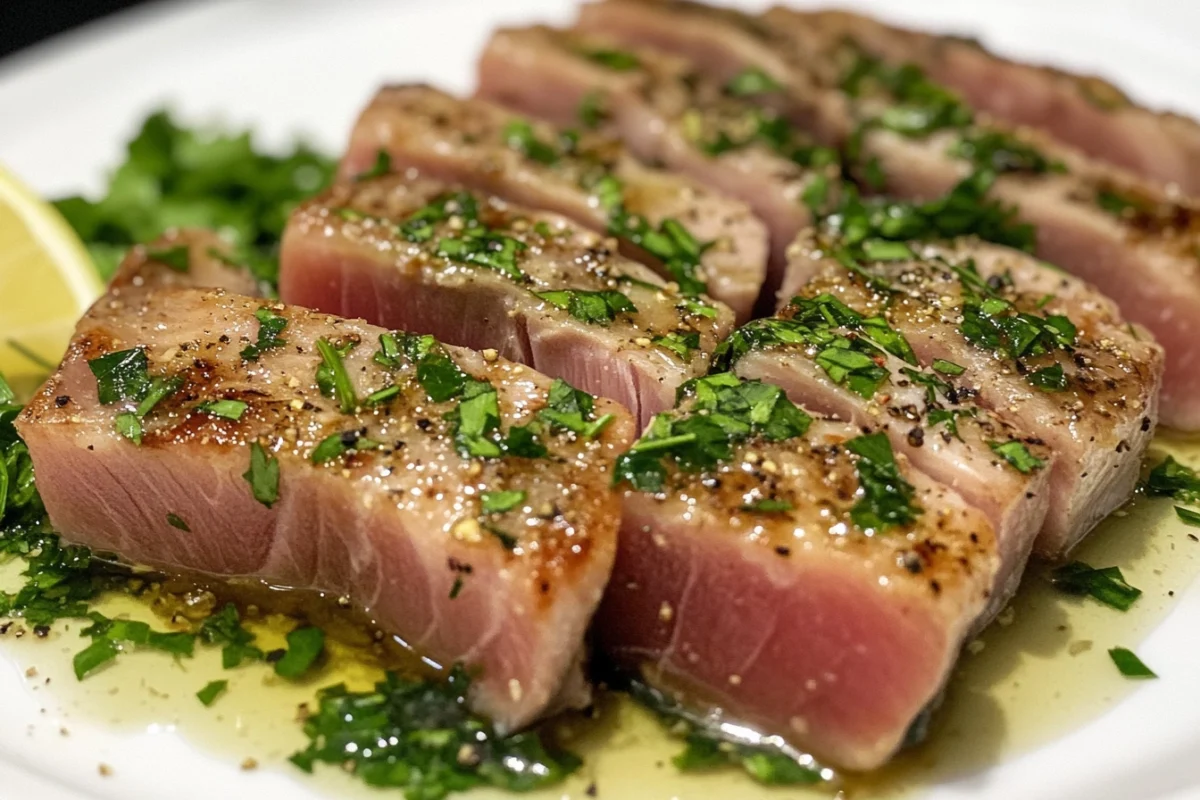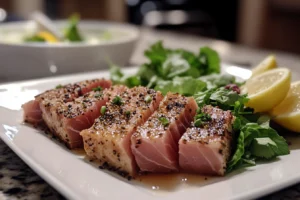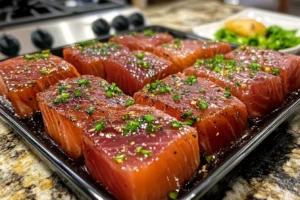This article provides a step-by-step guide to making delicious seared ahi tuna. Learn tips and tricks for the best results, ensuring a perfect sear every time.
Understanding the Ahi Tuna Recipe
Seared ahi tuna is a popular dish, known for its delicate flavor and beautiful presentation. Indeed, making it at home is simpler than you might think. This article will guide you through each step. Therefore, you can create a restaurant-quality meal in your own kitchen. The key to perfect seared ahi tuna is proper preparation and a hot pan. Chiefly, we will explore all aspects, from ingredient selection to serving. Accordingly, this guide will help you become proficient at preparing this dish.
Looking for a dessert to end your meal? Try the perfect cherry chip cake for a sweet finish.
Choosing the Best Ahi Tuna
The quality of your ahi tuna is essential to the final dish. Freshness is the most important thing to check for. Accordingly, look for tuna that is bright red. Furthermore, it should have a firm texture. Avoid tuna that looks dull or smells fishy. Moreover, it’s best to buy sushi-grade tuna. This type is safe to eat rare or seared. Specifically, it’s important to know where your tuna comes from. This ensures you’re choosing a good quality product.
Understanding Sushi-Grade Tuna
Sushi-grade doesn’t mean the tuna is legally graded. Instead, it indicates how the fish has been handled to minimize the risk of parasites. Therefore, when buying ahi tuna, be sure to ask your fishmonger. In addition, they can help you choose the best option. Undoubtedly, a reputable fishmonger will be knowledgeable about the source and handling of their products. This will lead to the best quality ahi tuna for your recipe.
Sustainable Sourcing
When buying ahi tuna, consider the sustainability of the fishing practices. Comparatively, look for certifications. Equally, check for information about the source. Meanwhile, choosing sustainably caught tuna helps protect ocean resources. Moreover, this will ensure the availability of these fish for future generations. Basically, responsible sourcing is important for the environment.
Storage Tips
Furthermore, if you’re not cooking it immediately, store the ahi tuna properly. Place it in the coldest part of your fridge. Make sure it’s well wrapped in plastic wrap. Consume within one or two days for optimal freshness. Basically, the fresher the tuna, the better the final result will taste. In addition, you could consider freezing the tuna if you’re not planning on using it soon. Wrap it tightly in plastic and then in freezer bags.
Freezing Tuna
However, be mindful that freezing might alter the texture slightly. Therefore, consume it as soon as you can after thawing. Indeed, this will ensure the best flavor and quality. Make sure to thaw frozen tuna in the refrigerator overnight. Never thaw it at room temperature. Thus, this will avoid the growth of harmful bacteria.
Preparing Your Ahi Tuna
Before you start cooking, proper prep is crucial. Initially, take the tuna out of the refrigerator. Let it sit for about 20-30 minutes. This will bring it closer to room temperature. Consequently, this helps with even cooking. Afterward, gently pat the tuna steaks dry with paper towels. This will help achieve a nice sear. Generally, this also prevents the oil from spattering too much in the pan.
The Importance of Drying
Drying the tuna is key. Specifically, it helps to remove excess moisture. Thus, the surface will sear better. Moisture can cause steaming instead of searing. Therefore, ensure that the tuna is thoroughly dry before seasoning. Especially, take your time and pat each steak carefully. Another helpful tip is to use several paper towels to ensure it’s completely dry.
Seasoning Your Ahi Tuna
Simple seasoning is best for ahi tuna. A simple mixture of salt and black pepper is a good place to start. However, you can also use other spices. For example, consider sesame seeds. Another option would be a bit of garlic powder. Ensure that you season all sides evenly. Undoubtedly, this will enhance the natural flavor of the tuna. Furthermore, try a mix of smoked paprika, onion powder, and a pinch of cayenne pepper for added flavor.
Exploring Marinades
Conversely, for a more intense flavor, consider a simple marinade. A mixture of soy sauce, ginger, and garlic is an ideal choice. Let the tuna marinate for about 15-20 minutes before searing. However, be mindful not to over-marinate the tuna. Doing so can alter the texture. Indeed, a little bit goes a long way.
Searing Your Ahi Tuna: Step-by-Step
Now, let’s move on to the cooking process. Chiefly, a hot pan is crucial for the best sear. Use a heavy-bottomed skillet, preferably cast iron. Place it over medium-high heat. Heat the pan for several minutes. This ensures that it’s hot enough. Next, add a high-heat oil, such as canola or grapeseed. However, avocado oil is another great choice.
How to Get the Perfect Sear
Once the oil is shimmering, carefully place the tuna steaks in the pan. Be sure not to overcrowd the pan. If needed, cook in batches. Meanwhile, let the tuna sear for about 1-2 minutes on each side. This will create a beautiful crust while keeping the inside rare. However, sear longer if you prefer your tuna more well-done. Conversely, don’t overcook, or it’ll be dry. Specifically, the timing depends on the thickness of your steaks.
Using a Meat Thermometer
Eventually, if you prefer a specific level of doneness, use a meat thermometer. Basically, a rare center will register around 115-125°F. A medium-rare will be around 130-135°F. However, don’t cook it beyond medium-rare. Thus, it can become too dry and lose its delicate texture.
Knowing When It’s Ready
You’ll know the tuna is ready when it has a golden-brown crust. The center should still be a vibrant red. Equally, use a spatula to carefully remove the tuna. Place it on a cutting board. Let it rest for a minute before slicing. Indeed, this will help the juices redistribute for maximum flavor. Moreover, resting the tuna is essential. This ensures it stays moist and flavorful.
Serving Your Seared Ahi Tuna
Seared ahi tuna is very versatile and can be served in many ways. For example, you can slice it and serve it over a salad. You can also use it in a poke bowl. In addition, it is great with a side of rice. Furthermore, you can pair it with a variety of sauces. Consider a light soy or teriyaki sauce. Additionally, consider a wasabi-mayo for a spicy kick.
Ideas for Sides and Sauces
Basically, the sides and sauces can be customized. Comparatively, you can keep it simple with a side salad. Consider adding a wasabi aioli for extra flavor. Moreover, you can explore Japanese-inspired sides like seaweed salad. Specifically, consider pickled ginger as well. Undoubtedly, the options are endless for enhancing your dish.
Garnish Suggestions for Ahi Tuna Recipe
Undoubtedly, garnishes can take the presentation to the next level. Generally, sesame seeds are a classic option. Another great choice is some freshly chopped scallions. Furthermore, consider a light drizzle of sesame oil. Specifically, this adds flavor and shine. Moreover, a touch of microgreens can add a visual appeal.
Creating a Poke Bowl
Specifically, to make a poke bowl, place a base of sushi rice in a bowl. Then, arrange the sliced ahi tuna on top. Afterward, add a variety of toppings. For example, consider avocado, edamame, cucumber, and seaweed salad. Finally, drizzle with your favorite sauce. This will complete the dish.
Health Benefits of Ahi Tuna
Ahi tuna is not only delicious, but also nutritious. Consequently, it is an excellent source of protein. Moreover, it’s rich in omega-3 fatty acids. These are good for your heart and brain health. Also, ahi tuna contains important nutrients. For example, there is selenium and B vitamins. Furthermore, it’s also a source of iron and potassium.
The Importance of Protein
Protein is vital for many body functions. For example, it aids muscle repair. Also, it supports your immune system. Additionally, it helps with producing hormones and enzymes. Therefore, including ahi tuna in your diet can be beneficial. Indeed, it’s a good source of lean protein.
Omega-3 Benefits
Omega-3 fatty acids are known for their anti-inflammatory effects. Indeed, they help lower blood pressure. They also support cognitive function. Thus, adding ahi tuna can help with overall well-being. Moreover, these acids play a key role in maintaining heart health.
Important Vitamins and Minerals
Ahi tuna is a good source of selenium. Particularly, this mineral acts as an antioxidant. It protects cells from damage. Additionally, the B vitamins in tuna are important for energy metabolism. Consequently, these nutrients contribute to overall health and vitality.
Making the Most of Your Ahi Tuna
Ultimately, the key to amazing seared ahi tuna is careful preparation and cooking. This dish is both elegant and simple to make. Therefore, following the steps outlined in this article will help you achieve perfection every time. You can adapt this ahi tuna recipe to your own taste. Especially, you can adjust seasoning and sides. Eventually, you’ll master this delightful dish. Hence, practice is key to perfection.
Tips for Repeat Success
Practice makes perfect. Therefore, don’t be discouraged if your first attempt isn’t flawless. Meanwhile, take notes on what worked well. Also note what could be improved. Hence, you’ll be able to improve your technique each time. Remember, a hot pan and well-dried tuna are crucial for a great sear. Additionally, always start with good quality tuna.
Ahi Tuna and Special Diets
Seared ahi tuna can fit into many dietary plans. For instance, it’s compatible with a low carb approach. It is also gluten-free naturally. Likewise, you can adapt the recipe to meet your specific preferences. Additionally, it is a good source of protein for those on a protein-rich diet. Moreover, this food is good for overall balance. Specifically, it can be a staple in a healthy and balanced diet.
Options for Vegetarians and Vegetable lovers
If you are looking for other options in your dish, consider a variety of vegetables. For example, add grilled asparagus. Another good option is roasted bell peppers. Comparatively, the vegetables you choose will depend on your own taste and needs.
Ahi Tuna Recipe: The Final Touch
Seared ahi tuna is a dish that impresses with its flavor and visual appeal. Furthermore, it showcases the quality and freshness of the tuna. Consequently, by following these tips and techniques, you can make a delicious meal. Therefore, you can enjoy the wonders of perfectly seared ahi tuna in the comfort of your own home. Undoubtedly, it’s a meal that’s good for you and tastes delicious.
Enjoying Your Creation
Now that you’ve created your dish, take the time to enjoy it. Indeed, sharing this meal with others can be even more rewarding. Thus, savor every bite of this simple yet sophisticated dish. The final result will undoubtedly impress and delight. Therefore, present it beautifully to showcase its qualities.
Storing Leftovers
If you have leftovers, store them in an airtight container. Put them in the refrigerator. Consume them within a day or two. However, keep in mind that seared tuna is best enjoyed fresh. It is less appealing when reheated. Specifically, it will lose its texture and flavor after a day or two.
Serving Suggestions
Consider serving the seared ahi tuna with a side of roasted vegetables, such as asparagus or broccoli. A small portion of rice or quinoa can also complement the dish nicely. Furthermore, consider some fresh greens. A light vinaigrette is a great dressing for the salad.
Ahi Tuna Recipe Conclusion
In conclusion, seared ahi tuna is a wonderful dish to prepare. With the right approach, you can consistently achieve amazing results. Ultimately, this guide will help you create a beautiful and delicious meal. Therefore, enjoy experimenting with the method. Find the perfect combination of flavors and sides. Specifically, you can make this dish your own. Hence, by following these detailed steps, you will master this dish and impress your friends and family. Finally, enjoy the amazing taste of homemade seared ahi tuna.
Final Thoughts and Summary
To summarize, we have explored the key aspects of preparing a perfect seared ahi tuna. Initially, we discussed the importance of choosing the right quality of ahi tuna. Afterward, we provided a step-by-step guide on prepping the fish. We then moved on to the cooking process. Specifically, focusing on getting the perfect sear. Finally, we covered serving and the health benefits of this amazing meal.
Call to Action
Try this ahi tuna recipe and tell us how it turns out. Feel free to adjust to your own taste! We are sure you’ll love this method. Share your experience with friends and family, as well. We would love to hear about your culinary adventure! Don’t forget to share photos of your own homemade seared ahi tuna!
Frequently Asked Questions (FAQs)
What is sushi-grade ahi tuna?
Sushi-grade ahi tuna refers to tuna that has been handled in a way that reduces the risk of parasites. It does not have a formal grading system. However, it means it is safe to eat raw or seared. Generally, it’s considered to be of a higher quality.
How do you know when ahi tuna is cooked?
Specifically, seared ahi tuna is ready when it has a golden-brown crust. The center should still be red. However, the time may need to be adjusted based on thickness. Equally, a meat thermometer can help you ensure it’s cooked to your preference.
What is the best oil for searing ahi tuna?
High-heat oils are best. For example, canola or grapeseed oil are good options. Additionally, these oils have a high smoke point. Therefore, they’re ideal for searing. Moreover, avocado oil is another ideal choice.
What are good side dishes for seared ahi tuna?
Generally, seared ahi tuna pairs well with a variety of sides. Rice, salads, and seaweed salad are all great options. Moreover, you can also try some Asian-inspired side dishes. Specifically, you can pair it with avocado, edamame, and a light soy sauce dressing.
For a heartier dinner, check out this baked ziti recipe without meat, which pairs wonderfully with a light seafood starter.



